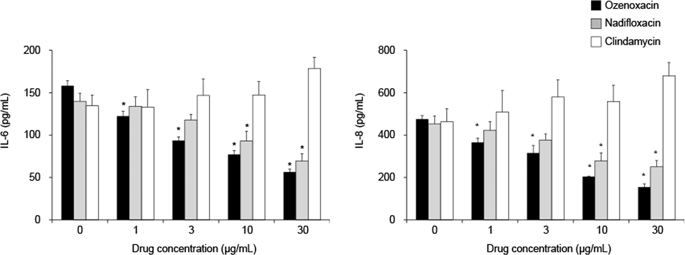当前位置:
X-MOL 学术
›
J. Antibiot.
›
论文详情
Our official English website, www.x-mol.net, welcomes your
feedback! (Note: you will need to create a separate account there.)
Anti-inflammatory effects of ozenoxacin, a topical quinolone antimicrobial agent.
The Journal of Antibiotics ( IF 2.1 ) Pub Date : 2020-01-23 , DOI: 10.1038/s41429-020-0278-5 Keisuke Tabara 1 , Rie Tamura 1 , Aki Nakamura 1 , Sachi Mori 1 , Takamichi Kitano 1 , Koki Fujikawa 1 , Mika Fujikawa 1 , Kazuaki Okamoto 1 , Shoji Kanayama 1 , Hideya Uratsuji 1 , Fumiaki Ikeda 1 , Tatsumi Matsumoto 1
The Journal of Antibiotics ( IF 2.1 ) Pub Date : 2020-01-23 , DOI: 10.1038/s41429-020-0278-5 Keisuke Tabara 1 , Rie Tamura 1 , Aki Nakamura 1 , Sachi Mori 1 , Takamichi Kitano 1 , Koki Fujikawa 1 , Mika Fujikawa 1 , Kazuaki Okamoto 1 , Shoji Kanayama 1 , Hideya Uratsuji 1 , Fumiaki Ikeda 1 , Tatsumi Matsumoto 1
Affiliation

|
Ozenoxacin is a topical quinolone showing potent antimicrobial activities against Gram-negative and Gram-positive bacteria and is widely used for the treatment of inflammatory acne. However, the anti-inflammatory activities of ozenoxacin have not been examined so far. In the present study, we investigated the in vitro and in vivo anti-inflammatory effects of ozenoxacin. The production of interleukin (IL)-6 and IL-8 by human epidermal keratinocytes stimulated by heat-killed Cutibacterium acnes was significantly inhibited by ozenoxacin at concentrations from 1 to 30 μg ml-1. Likewise, the production of IL-6, IL-8, and tumor necrosis factor alpha by stimulated THP-1 cells, a human monocyte cell line, was inhibited by ozenoxacin at concentrations from 1 to 30 μg ml-1. The production of IL-1β by THP-1 was also inhibited by ozenoxacin at the concentration of 30 μg ml-1. Phosphorylation of the mitogen-activated protein kinases and degradation of IκB-α, an inhibitory factor of NF-κB in keratinocytes and THP-1 cells, was increased by stimulation with heat-killed C. acnes. Of these activated intracellular pathways, the p38 phosphorylation pathway was remarkably reduced by ozenoxacin in both keratinocytes and THP-1 cells. In addition, the application of 2% ozenoxacin suppressed the increase in the ear thickness of rats induced by an intracutaneous injection of heat-killed C. acnes. These findings suggest that ozenoxacin possesses an anti-inflammatory activity, which may contribute to its therapeutic effects on inflammatory acne.
中文翻译:

ozenoxacin(一种局部喹诺酮抗微生物剂)的抗炎作用。
奥泽沙星是一种局部用喹诺酮类药物,对革兰氏阴性和革兰氏阳性细菌显示出有效的抗菌活性,被广泛用于治疗炎性痤疮。然而,迄今为止尚未检查过奥泽沙星的抗炎活性。在本研究中,我们调查了奥泽沙星的体外和体内抗炎作用。在1至30μgml-1的浓度下,奥泽沙星显着抑制了由热杀死的痤疮痤疮杆菌刺激的人表皮角质形成细胞产生白介素(IL)-6和IL-8。同样,刺激的THP-1细胞(一种人单核细胞系)产生的IL-6,IL-8和肿瘤坏死因子α的浓度也被ozenoxacin抑制,浓度为1至30μgml-1。浓度为30μgml-1的ozenoxacin也抑制了THP-1产生的IL-1β。通过用热杀死的痤疮丙酸杆菌刺激,增加了促分裂原活化蛋白激酶的磷酸化和IκB-α的降解,IκB-α是角质形成细胞和THP-1细胞中NF-κB的抑制因子。在这些激活的细胞内途径中,ozenoxacin在角质形成细胞和THP-1细胞中均显着降低了p38磷酸化途径。此外,使用2%的奥泽沙星可抑制因皮内注射热杀死的痤疮丙酸杆菌而引起的大鼠耳厚的增加。这些发现表明,奥泽沙星具有抗炎活性,这可能有助于其对炎性痤疮的治疗作用。通过用热杀死的痤疮丙酸杆菌刺激,增加了促分裂原活化蛋白激酶的磷酸化和IκB-α的降解,IκB-α是角质形成细胞和THP-1细胞中NF-κB的抑制因子。在这些激活的细胞内途径中,ozenoxacin在角质形成细胞和THP-1细胞中均显着降低了p38磷酸化途径。此外,使用2%的奥泽沙星可抑制因皮内注射热杀死的痤疮丙酸杆菌而引起的大鼠耳厚的增加。这些发现表明,奥泽沙星具有抗炎活性,这可能有助于其对炎性痤疮的治疗作用。通过用热杀死的痤疮丙酸杆菌刺激,增加了促分裂原活化蛋白激酶的磷酸化和IκB-α的降解,IκB-α是角质形成细胞和THP-1细胞中NF-κB的抑制因子。在这些激活的细胞内途径中,ozenoxacin在角质形成细胞和THP-1细胞中均显着降低了p38磷酸化途径。此外,使用2%的奥泽沙星可抑制因皮内注射热杀死的痤疮丙酸杆菌而引起的大鼠耳厚的增加。这些发现表明,奥泽沙星具有抗炎活性,这可能有助于其对炎性痤疮的治疗作用。ozenoxacin在角质形成细胞和THP-1细胞中均显着降低了p38磷酸化途径。此外,使用2%的氧氮沙星可抑制因皮内注射热杀死的痤疮丙酸杆菌而引起的大鼠耳厚的增加。这些发现表明奥泽沙星具有抗炎活性,这可能有助于其对炎性痤疮的治疗作用。ozenoxacin在角质形成细胞和THP-1细胞中均显着降低了p38磷酸化途径。此外,使用2%的奥泽沙星可抑制因皮内注射热杀死的痤疮丙酸杆菌而引起的大鼠耳厚的增加。这些发现表明奥泽沙星具有抗炎活性,这可能有助于其对炎性痤疮的治疗作用。
更新日期:2020-01-23
中文翻译:

ozenoxacin(一种局部喹诺酮抗微生物剂)的抗炎作用。
奥泽沙星是一种局部用喹诺酮类药物,对革兰氏阴性和革兰氏阳性细菌显示出有效的抗菌活性,被广泛用于治疗炎性痤疮。然而,迄今为止尚未检查过奥泽沙星的抗炎活性。在本研究中,我们调查了奥泽沙星的体外和体内抗炎作用。在1至30μgml-1的浓度下,奥泽沙星显着抑制了由热杀死的痤疮痤疮杆菌刺激的人表皮角质形成细胞产生白介素(IL)-6和IL-8。同样,刺激的THP-1细胞(一种人单核细胞系)产生的IL-6,IL-8和肿瘤坏死因子α的浓度也被ozenoxacin抑制,浓度为1至30μgml-1。浓度为30μgml-1的ozenoxacin也抑制了THP-1产生的IL-1β。通过用热杀死的痤疮丙酸杆菌刺激,增加了促分裂原活化蛋白激酶的磷酸化和IκB-α的降解,IκB-α是角质形成细胞和THP-1细胞中NF-κB的抑制因子。在这些激活的细胞内途径中,ozenoxacin在角质形成细胞和THP-1细胞中均显着降低了p38磷酸化途径。此外,使用2%的奥泽沙星可抑制因皮内注射热杀死的痤疮丙酸杆菌而引起的大鼠耳厚的增加。这些发现表明,奥泽沙星具有抗炎活性,这可能有助于其对炎性痤疮的治疗作用。通过用热杀死的痤疮丙酸杆菌刺激,增加了促分裂原活化蛋白激酶的磷酸化和IκB-α的降解,IκB-α是角质形成细胞和THP-1细胞中NF-κB的抑制因子。在这些激活的细胞内途径中,ozenoxacin在角质形成细胞和THP-1细胞中均显着降低了p38磷酸化途径。此外,使用2%的奥泽沙星可抑制因皮内注射热杀死的痤疮丙酸杆菌而引起的大鼠耳厚的增加。这些发现表明,奥泽沙星具有抗炎活性,这可能有助于其对炎性痤疮的治疗作用。通过用热杀死的痤疮丙酸杆菌刺激,增加了促分裂原活化蛋白激酶的磷酸化和IκB-α的降解,IκB-α是角质形成细胞和THP-1细胞中NF-κB的抑制因子。在这些激活的细胞内途径中,ozenoxacin在角质形成细胞和THP-1细胞中均显着降低了p38磷酸化途径。此外,使用2%的奥泽沙星可抑制因皮内注射热杀死的痤疮丙酸杆菌而引起的大鼠耳厚的增加。这些发现表明,奥泽沙星具有抗炎活性,这可能有助于其对炎性痤疮的治疗作用。ozenoxacin在角质形成细胞和THP-1细胞中均显着降低了p38磷酸化途径。此外,使用2%的氧氮沙星可抑制因皮内注射热杀死的痤疮丙酸杆菌而引起的大鼠耳厚的增加。这些发现表明奥泽沙星具有抗炎活性,这可能有助于其对炎性痤疮的治疗作用。ozenoxacin在角质形成细胞和THP-1细胞中均显着降低了p38磷酸化途径。此外,使用2%的奥泽沙星可抑制因皮内注射热杀死的痤疮丙酸杆菌而引起的大鼠耳厚的增加。这些发现表明奥泽沙星具有抗炎活性,这可能有助于其对炎性痤疮的治疗作用。











































 京公网安备 11010802027423号
京公网安备 11010802027423号